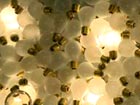| Videos | • Latest |
|
• Feature | • Sports | • Your Videos |
Science behind everyday objects

 0 Comment(s)
0 Comment(s) Print
Print E-mail
CNTV, November 11, 2011
E-mail
CNTV, November 11, 2011
Hidden Heroes are the everyday objects we just couldn't live without. Now, a new exhibition in the U.K. looks at the surprising stories behind some of the most seemingly mundane household and office essentials - like zippers and lightbulbs.
The incandescent light bulb - a bright idea if ever there was one.
This everyday object is usually used to light more precious exhibits in museums around the world... But today it is the star of the show.
Here at London's Science Museum the Hidden Heroes exhibition celebrates the genius of everyday things.
The paper clip might be strewn carelessly across office desks around the world, but this handy hero is a lasting example of utilitarian design.
British physicist Robert Hooke's 1678 theory of the spring was put to good use by the machinery of the late 19th Century to create this office essential.
The ring binder was another common sight in the 20th Century office, particularly before digital computer records.
Its lever arch mechanism was first patented back in 1886 and it is still in use today.
Susan Mossman, project leader from London Science Museum, said: "You could think about this exhibition of where we're taking things for granted. For things like the paper clip, the ring binder the elastic band - things we use everyday and we don't even think about but somebody actually thought them up, or a series of people thought them up and were gradually improved. These are now very good designs and some of them have lasted now for hundreds of years. The elastic band has lasted for 150 years in its current design, cheap, easily mass produced, produced in its billions and we're still finding use for today."
One of the oldest exhibits is the pencil which can trace its origins back to the 16th Century when a graphite deposit was discovered in Cumberland, northern England.
Today pencils come in all shapes and colours but the technique of firing a core of clay and graphite in a kiln before encasing it in wood is still the same.
The LEGO brick is perhaps Denmark's most famous export.
The first injection moulded bricks rolled off the production line back in 1949 and they've gone from strength to strength.
The creative possibilities of LEGO helped earn it the accolade of "Toy of the 20th Century" by the British Association of Toy Retailers.
Most of us use a coat hanger every single day without considering its origins.
Susan Mossman said: "Behind me is the coat hanger, the humble coat hanger. Who invented it? I was surprised to find out there are 189 patents at least for coat hangers, anything and everything. But there was a gentleman called Albert Parkhouse who went into work in around 1907, there weren't enough coat hangers to go around and he bent a bit of wire into a coat hanger shape and so the birth of the first wire coat hanger."
Finally, there was a place for the most British of everyday items - the tea bag.
However, its origins are American and accidental, when a trader began shipping samples in small silk bags. Some of his customers accidentally dipped a sack in boiling water and the tea infused.
Tea bags made from paper fiber did not become common until after 1930 when new production techniques allowed bags to be heat sealed.
Hidden Heroes runs through?






Go to Forum >>0 Comment(s)